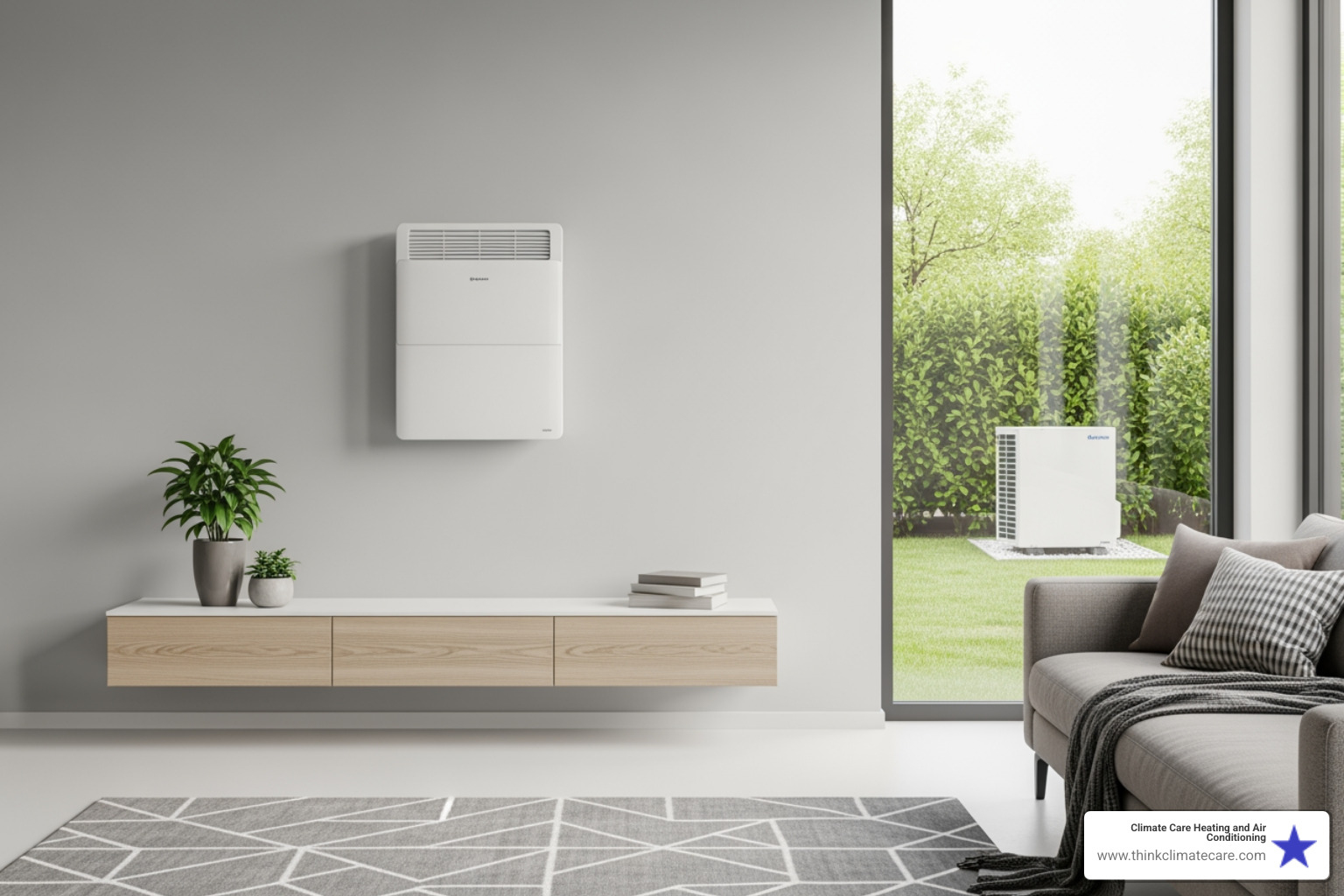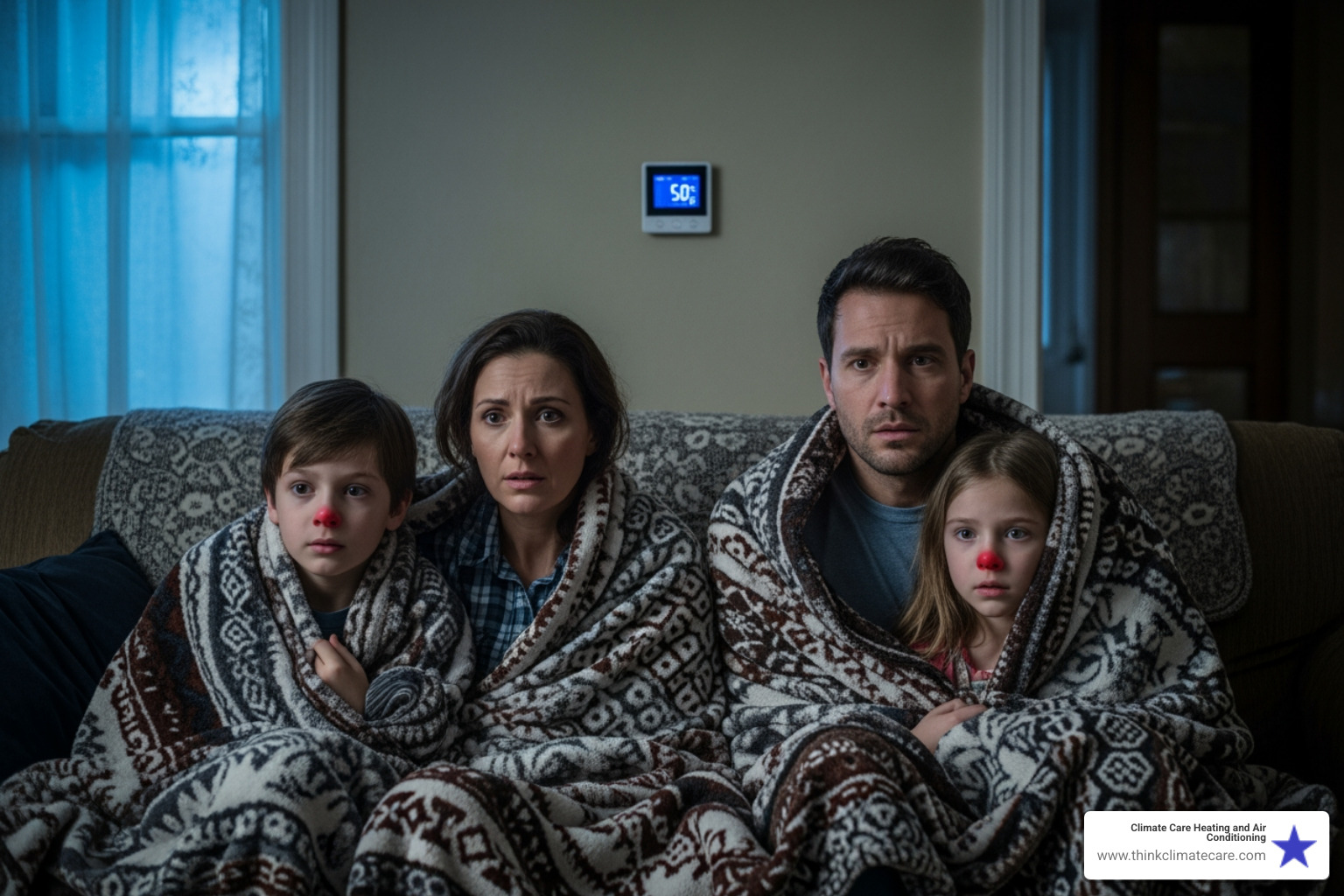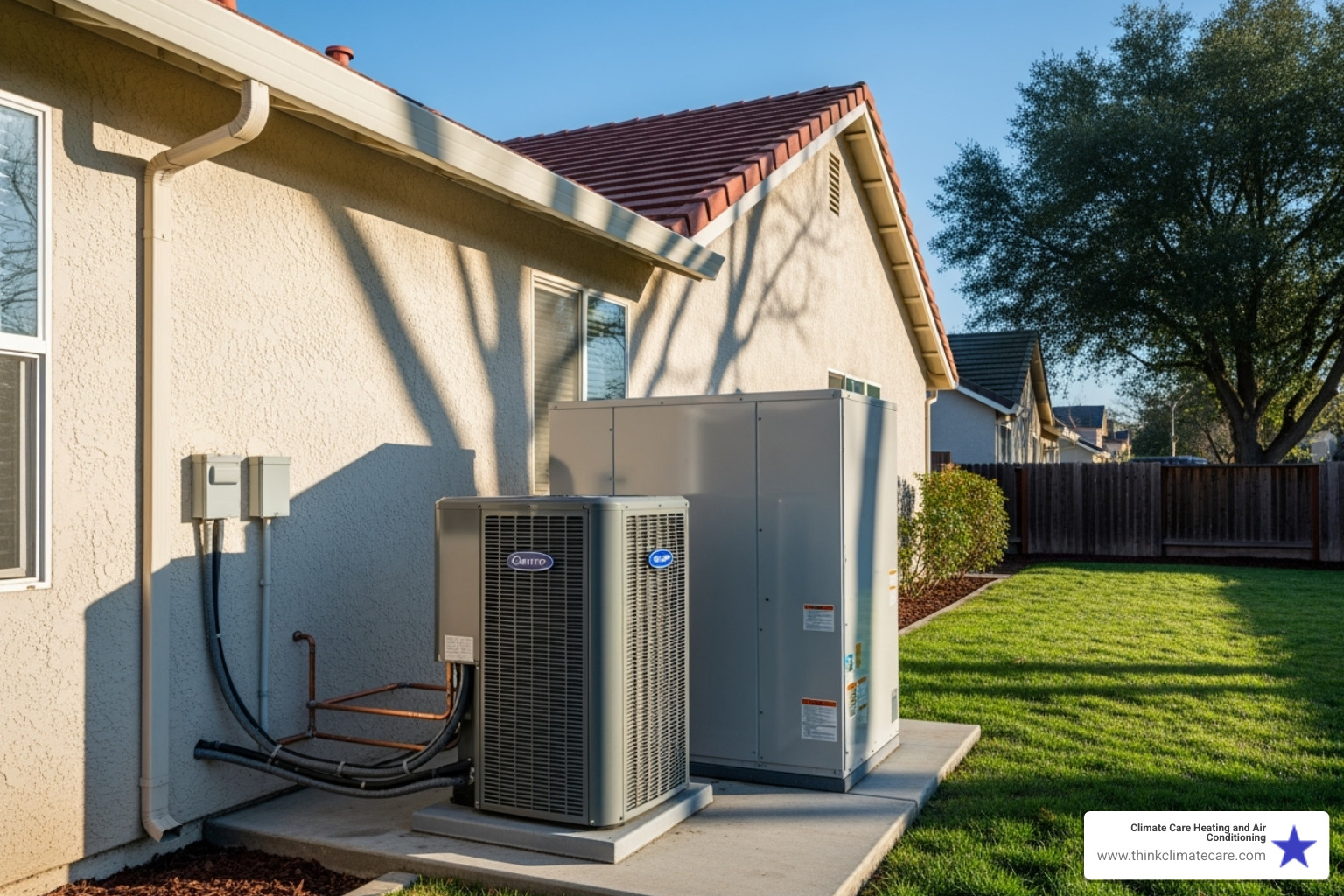Your HVAC is Blowing Cold Air: A Quick Fix Guide
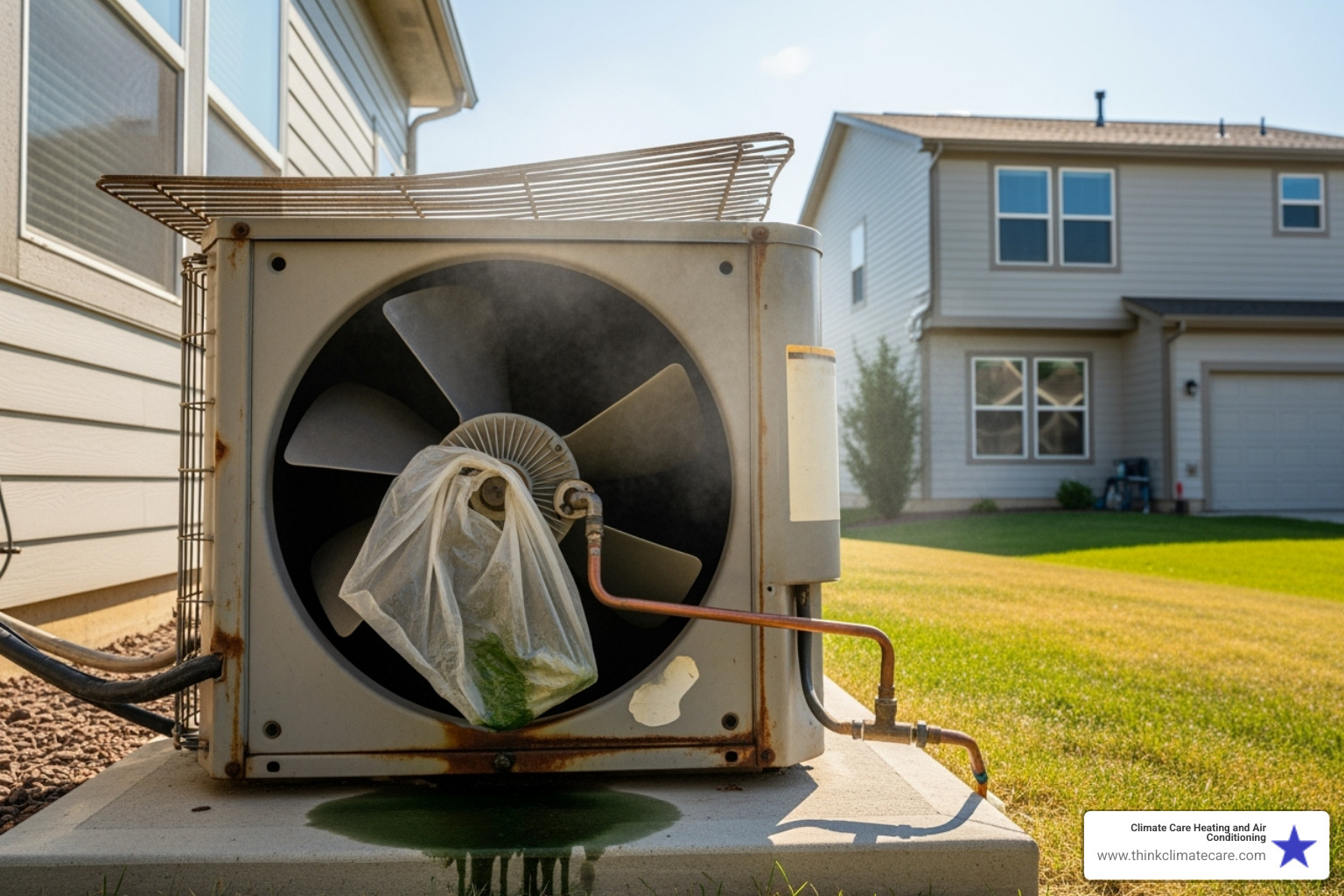
Why Your AC Not Cooling Is More Than Just an Inconvenience
When your AC not cooling hits during Manteca's sweltering summer heat, it's not just uncomfortable - it's urgent. Three-quarters of all homes in the US have air conditioners, and when yours stops working, you need answers fast.
Most common reasons your AC isn't cooling:
- Thermostat issues - Wrong settings or dead batteries
- Dirty air filter - Blocks airflow and can shut down the system
- Tripped circuit breaker - Cuts power to your unit
- Frozen evaporator coils - Prevents cold air circulation
- Low refrigerant - System can't absorb heat properly
- Blocked outdoor unit - Debris prevents heat release
The good news? Many cooling problems have simple fixes you can try in just 15 minutes. For example, swapping out a dirty air filter takes less time than waiting for a repair truck.
Other issues like refrigerant leaks or compressor failures need professional help. Running an AC when it's not properly cooling can turn a minor issue into a major component failure, so knowing when to call Climate Care Heating and Air Conditioning can save you hundreds of dollars.
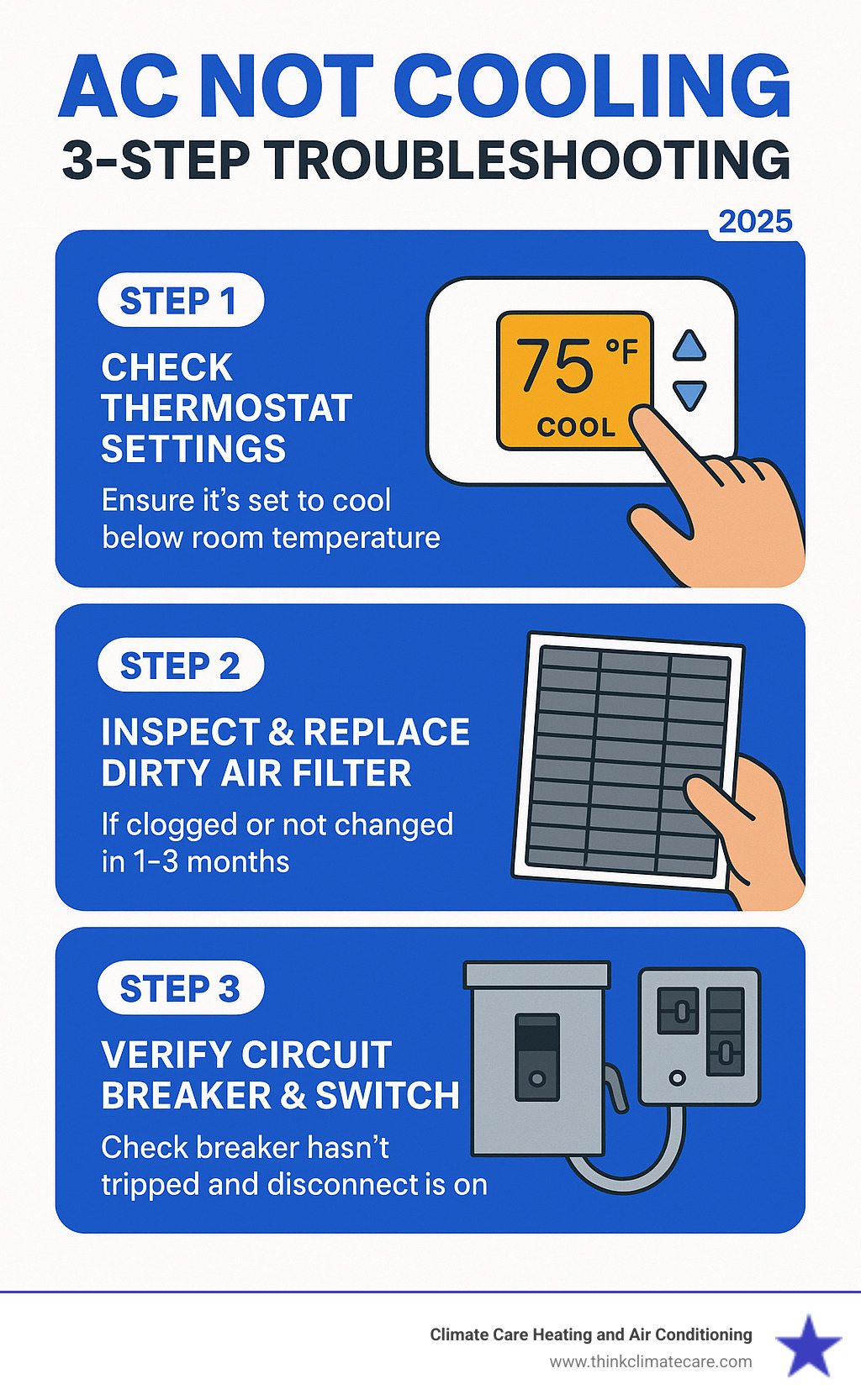
Simple DIY Checks You Can Do in 15 Minutes
When you're facing an AC not cooling situation, don't panic. Before calling for help, there are several quick fixes you can try yourself. Many cooling problems have surprisingly simple solutions.
Troubleshooting an AC Not Cooling Due to Thermostat Issues
Your thermostat is the command center for your cooling system, and sometimes it's the source of the problem.
Start with the basics: check your thermostat settings. Yes, it sounds almost too simple, but you'd be amazed how often someone accidentally bumps the setting to "Heat" or "Off" while dusting. Make sure it's set to "Cool" mode and that your target temperature is actually lower than what your home feels like right now. If your house is already feeling like an oven at 78°F, setting the thermostat to 80°F won't exactly inspire your AC to spring into action.
Here's something many homeowners don't realize: AC units typically aren't designed to maintain indoor temperatures cooler than 75°F. If you're trying to turn your home into an arctic paradise when it's 100°F outside, your system might struggle or shut down completely.
Next, look at your fan setting. If it's set to "ON," your fan runs constantly, circulating air whether it's cool or not. This can trick you into thinking your AC not cooling when it's actually just moving room-temperature air around. Switch it to "AUTO" so the fan only runs when your system is actively cooling.
Dead batteries are the silent troublemakers of the HVAC world. If your thermostat screen looks dim, blank, or is acting wonky, try swapping in fresh batteries. It's one of those "turn it off and on again" moments that actually works.
Finally, consider where your thermostat lives. Is it getting blasted by afternoon sunlight through a nearby window? Is there a lamp, TV, or other heat source nearby? These can confuse your thermostat into thinking your home is warmer than it really is. When the indoor temperature drops to 64°F or below, your AC's compressor might not even turn on because it doesn't sense any need to cool.
What to Do When Your AC is Not Cooling Because of Airflow Problems
Think of airflow as your AC system's lifeline. When it gets choked off anywhere in the process, your cooling suffers dramatically.
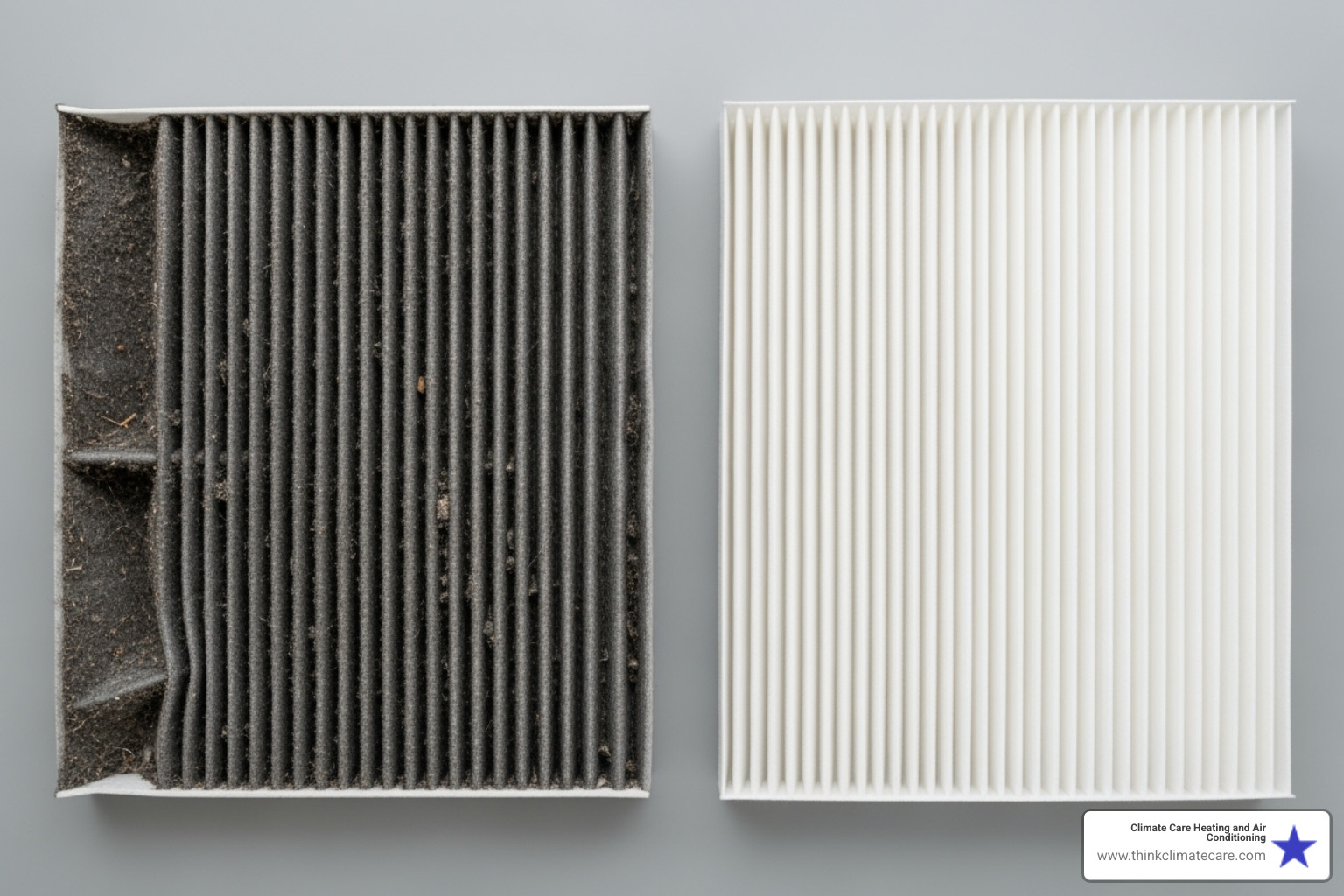
The biggest airflow villain is a dirty air filter. When clogged with dust, pet hair, and debris, your system has to work much harder to cool your home. Signs of a clogged filter include weak airflow from your vents, musty odors, or even ice forming on your indoor coils.
How often should you replace your filter? Every 1 to 3 months is the general rule, but if you have pets, allergies, or live in a dusty area, you might need to check it monthly. It's honestly one of the easiest things you can do to keep your system happy.
Now, let's head outside to your outdoor condenser unit. Take a look around it - is it buried under leaves, grass clippings, or surrounded by overgrown bushes? Your outdoor unit needs to breathe freely to release all that heat it's pulling from inside your home. Clear away any debris and give your unit at least two feet of space on all sides. A gentle rinse with your garden hose can help clean the condenser coils and remove built-up dirt.
Don't forget about your indoor air registers either. Walk through your home and make sure furniture, rugs, or curtains aren't blocking the vents. Check that all the registers are actually open - sometimes they get accidentally closed during cleaning. Blocked or closed air registers create pressure imbalances that can cause hot and cold spots throughout your home.
Checking for Basic Power Problems
Sometimes your AC just needs a little electrical encouragement to get back to work.
Start with your circuit breaker panel. If your AC isn't turning on at all or keeps shutting off randomly, look for the breaker labeled for your AC unit. A tripped circuit breaker will be in the middle position or flipped to "off." To reset it properly, push it firmly to the "off" position first, then flip it back to "on." If it immediately trips again, don't keep trying - that's a sign of a more serious electrical issue that needs professional attention.
Next, check your outdoor unit disconnect box. This small gray box sits near your outdoor condenser and acts like a main power switch. Make sure the switch inside is flipped to the "on" position. It's surprisingly common for this to get accidentally turned off during yard work or storms.
Finally, locate your furnace or air handler power switch. This looks just like a regular light switch and is usually mounted on or near your indoor unit. It might be in a utility room, basement, or attic. Make sure it's in the "on" position - you'd be surprised how often someone flips it off by mistake.
For specific instructions about your particular system, find your Owner's Manual for specific instructions. Every unit is a little different, and your manual will have the exact details for your model.
Common Mechanical Reasons for an AC Not Cooling
If your DIY checks haven't solved the mystery of your AC not cooling, it might be time to dig into some common mechanical issues. These often require a closer look, and while some might still be DIY-friendly, others are best left to our certified professionals.
Frozen Evaporator Coils
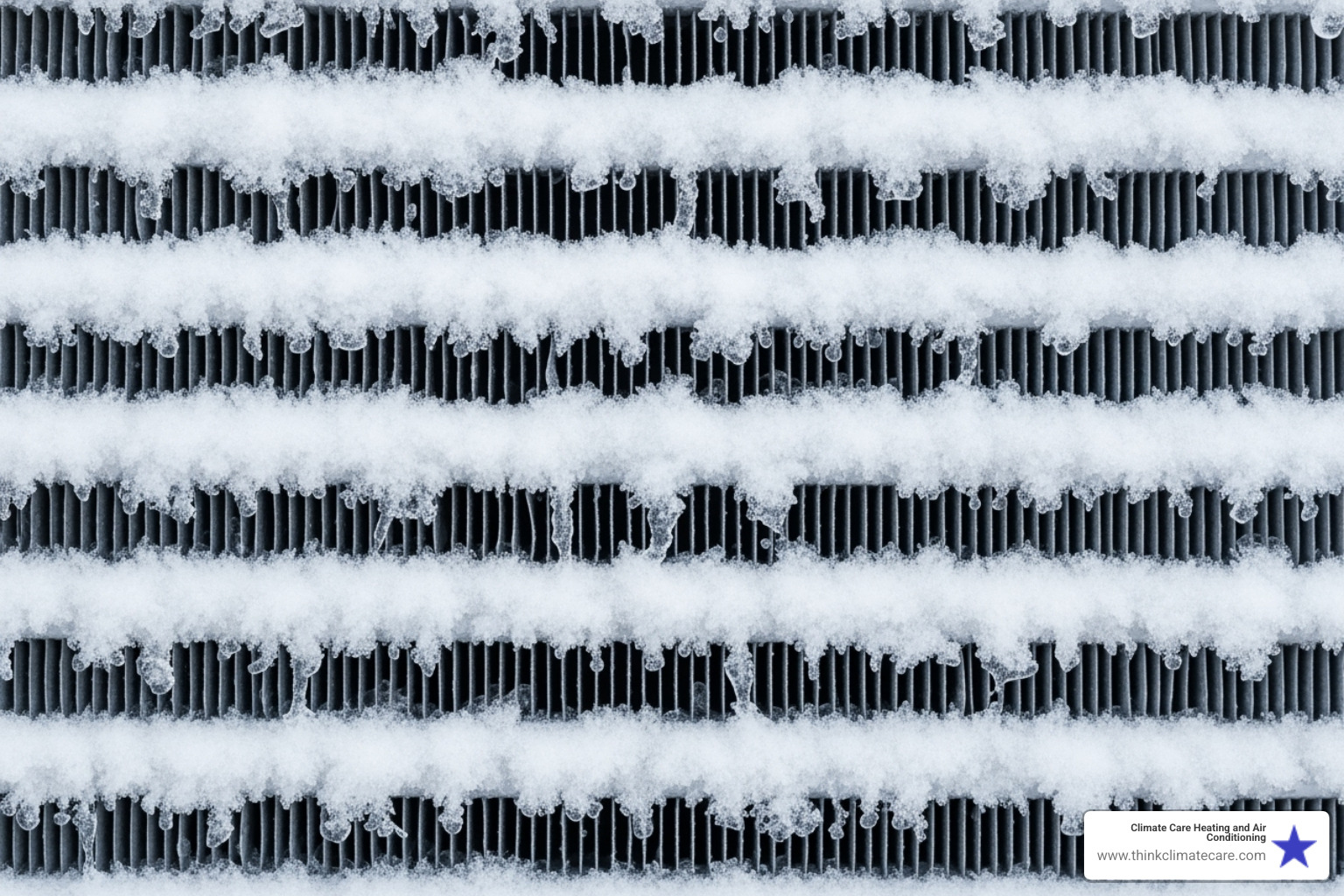
Seeing ice on your AC unit means trouble. Frozen evaporator coils will prevent your AC from blowing cold air. The evaporator coil in your indoor unit absorbs heat from your home's air. If not enough warm air flows over it, the coil gets too cold and any moisture on it turns to ice.
So, what causes this icy mess? The most common reasons usually boil down to poor airflow. This could be from a really dirty air filter, vents that are blocked or closed, or even an indoor fan that isn't working quite right. All of these restrict the warm air that needs to pass over the coil. Another big reason coils freeze is low refrigerant levels. If your system doesn't have enough refrigerant, the pressure drops, making the coil excessively cold and prone to freezing.
If you spot ice building up on your AC coils, here's what you need to do:
- Turn off your AC system immediately. Continuing to run it will only make the ice worse and could even cause serious damage to your compressor, which is a very expensive repair.
- Set your thermostat's fan to "ON." This will help circulate air over the coils, which speeds up the thawing process. Please, don't try to chip away the ice! You could easily damage the delicate coils. Melting can take a while, sometimes anywhere from 1 to 24 hours, so patience is truly key here.
- Check your air filter. If it's looking dirty, go ahead and replace it. A clogged filter is a very common cause of airflow problems.
Once all the ice has completely melted, you can turn your AC back on. But if those coils freeze up again, it's a clear sign of a deeper issue that needs a professional eye. Give us a call, and we'll figure out what's really going on.
Low Refrigerant and Potential Leaks
Imagine your AC system as a giant sponge that soaks up heat from your home and then squeezes it out into the outdoors. The "liquid" in that sponge is called refrigerant. This special chemical compound cycles through your AC, changing from a liquid to a gas to absorb heat, and then back to a liquid to release it outside. It's the absolute core of how your home stays cool.
If your AC refrigerant is low, it becomes less pressurized, which means it can't transfer heat efficiently. This results in your AC struggling to cool your home properly, leaving you with that frustrating AC not cooling feeling. Unlike the refrigerant in your car, your home AC unit operates in a closed system. This means it should never "run out" of refrigerant. So, if your refrigerant levels are low, it's almost always because there's a leak somewhere in the system.
How can you tell if you might have a refrigerant leak? Look (or listen) for these signs:
- Hissing or bubbling noises coming from your indoor unit or the refrigerant lines.
- Reduced cooling capacity – your AC just isn't cooling as well as it used to.
- Frozen evaporator coils, as we just discussed, can be a symptom of low refrigerant.
- You might even notice an oily residue on the refrigerant lines or around the outdoor unit, as refrigerant contains a lubricant that can escape with it.
If you suspect a refrigerant leak, it's really important to call a professional right away. Not only do we need to find and fix the leak before we can safely recharge the system, but refrigerant can also be hazardous. While rare, a significant leak can potentially lead to refrigerant poisoning, and it's also not good for the environment. Our team is fully trained and equipped to handle refrigerants safely and efficiently, making sure your system is sealed up tight and recharged correctly.
Leaky Air Ducts
Think of your home's ductwork as the circulatory system for your HVAC. It's responsible for carrying that wonderful cool air from your AC unit to every single room. But what happens if that system has a leak?
Air duct leaks can seriously mess with your AC's ability to cool. They let conditioned air escape into unconditioned spaces (like your hot attic or damp crawl space) or even pull in unconditioned air from those spaces. This can lead to a few frustrating problems:
- Uneven temperatures throughout your home. You'll find some rooms feeling perfectly comfortable while others remain stubbornly warm, creating annoying hot and cold spots.
- Increased energy bills. Your AC has to work much harder and run longer to try and reach the temperature you've set, wasting energy and sending your utility costs soaring.
- Reduced indoor air quality. Leaks can act like a vacuum, pulling in dust, allergens, and other contaminants from attics or crawl spaces right into your living areas.
While you might spot obvious tears or disconnections in ducts you can easily reach, properly finding and sealing all those sneaky leaks really requires professional expertise. Our technicians use specialized tools to test your ductwork's integrity and seal any breaches, ensuring maximum efficiency and comfort throughout your home.
When to Call a Professional: Diagnosing Major Component Failures
We've covered DIY fixes and common mechanical issues, but some problems are too complex or dangerous for a homeowner. They require specialized tools and knowledge. This is when it's time to call Climate Care Heating and Air Conditioning. Tackling major component failures yourself can turn a costly repair into an expensive system replacement. Knowing when to call a certified technician can save you headaches and money.
DIY FixesProfessional RepairsThermostat CheckRefrigerant Leak Detection & RechargeAir Filter ReplacementCompressor ReplacementClearing Debris from Outdoor UnitElectrical System FaultsResetting Circuit BreakerFan Motor ReplacementThawing Frozen Coils (initial step)Capacitor/Contactor ReplacementUnblocking Air RegistersDuctwork Repair & SealingChecking Disconnect Box & Power SwitchDiagnosing & Repairing Control Board Issues
Compressor, Capacitor, and Fan Motor Issues
These components are the real workhorses of your AC system. When one of them goes out, your AC not cooling becomes a very noticeable problem, and it's definitely time for a pro.
Let's talk about the compressor. Think of it as the "heart" of your AC. Its job is to pump the refrigerant, getting it ready to absorb heat from your home. If this vital part fails, your AC might turn on, but it won't be blowing any cold air. You might notice your outdoor unit isn't running at all, or perhaps it's making a strange humming, buzzing, or grinding noise. Sometimes, a bad compressor can even trip your circuit breaker repeatedly. In the worst-case scenario, like a "grounded" compressor (meaning the motor's wiring has failed internally), it often means you'll need a whole new outdoor unit.
Then there are the fan motors – both inside and outside your home. If your outdoor fan isn't spinning, the unit can't release the heat it's pulled from your house, leaving you with warm air from your vents. If the indoor fan isn't working, that lovely cool air your AC does produce won't get circulated through your home. You might hear a buzzing sound, or simply see that the fan blades aren't moving.
A bad capacitor is another common electrical issue. Imagine capacitors as tiny, powerful batteries that give your AC's motors (like the compressor and fan motor) the necessary "kick" to start up. If this little component fails, the motor it's supposed to power will just hum and refuse to turn on. While a capacitor replacement is usually less expensive than a new compressor, it involves working with electricity, so it's a job for a trained professional for safety.
Finally, we have the malfunctioning contactor. This component acts like a special switch, controlling the flow of electricity to key parts of your AC, including the compressor and fan. If the contactor gets stuck or simply stops working, power won't reach where it needs to go. This can lead to symptoms similar to a bad capacitor or compressor, highlighting why a professional diagnosis is so important to pinpoint the exact problem.
The Age and Size of Your AC Unit
Sometimes, the issue isn't just a broken part, but the entire system being past its prime or simply not the right fit for your home.
Most AC units are built to last a good while, typically between 10 and 15 years. But just like any appliance, as your unit gets older, its cooling power can start to fade. You might notice it struggling to reach the temperature you've set, or perhaps it runs almost constantly just to try and keep up. Your energy bills might also start creeping up, and you might find yourself calling for repairs more and more often. These are all big clues that your aging system might be nearing the end of its useful life.
Another often-overlooked problem is an undersized AC unit. This happens when your AC system isn't powerful enough for the size of your home. If your unit was improperly sized during installation, it will constantly struggle to keep your home cool, especially when the weather is at its hottest. This constant running puts a lot of stress on the system, leading to more wear and tear, higher utility bills, and ultimately, a shorter lifespan for the unit. While three-quarters of all US homes have air conditioners, having one that's the wrong size can make your home just as uncomfortable as having no AC at all. In these cases, the best solution might not be a repair, but a proper system replacement to ensure your home stays cool and comfortable.
Frequently Asked Questions about AC Cooling Problems
We hear a lot of questions from our customers in Manteca, Modesto, Stockton, Tracy, and beyond (including Antelope, Carmichael, Ceres, Citrus Heights, Elk Grove, Elverta, Escalon, Fair Oaks, Folsom, French Camp, Galt, Lathrop, Lodi, Mountain House, Natomas, North Highlands, Oakdale, Orangevale, Patterson, Rancho Cordova, Rio Linda, Ripon, Riverbank, Rocklin, Roseville, Sacramento, Salida, Turlock, and Woodbridge!). It’s no surprise that when your AC not cooling becomes an issue, these are some of the most common things people want to know.
Why is my AC running but not blowing cold air?
This is perhaps the most frustrating symptom when your AC not cooling becomes a reality. You hear the unit humming, hoping for that sweet relief, but all you get is stale, warm air. It feels like your AC is working hard but achieving nothing!
Typically, this happens for a few key reasons. First, a dirty air filter is a big culprit. It blocks the airflow your system needs to properly cool the air. Next, your evaporator coils might be frozen. If ice covers these vital coils, air can't pass over them to get cooled.
Then there's the issue of low refrigerant. If your system doesn't have enough of this special chemical, it simply can't absorb the heat from your home, meaning the air never gets cold. A more serious issue could be a compressor problem. This is the heart of your AC, and if it's not working right, the refrigerant won't cycle, and you'll get no cooling at all. Lastly, a blocked outdoor condenser unit can cause problems. If this part of your AC can't release the heat it's pulled from your home, the whole system becomes inefficient and blows warm air.
Always start by checking those simple DIY fixes we talked about earlier – your thermostat, air filter, and power. If those don't solve the mystery, it's definitely time to give us a call so we can diagnose the real mechanical issue.
How often should I really change my AC air filter?
The general guideline for changing your AC air filter is every 1 to 3 months. Think of it as a small, easy task that makes a huge difference!
However, some factors might mean you need to change it even more often. For example, if you have pets that shed, you'll likely want to swap out that filter monthly. Same goes if anyone in your home suffers from allergies or asthma; a fresh filter helps keep indoor air quality high and reduces irritants.
Your local air quality plays a role too. If there's a lot of construction dust, pollen, or even wildfire smoke in the air, your filter will get clogged faster. Finally, a busy household with more occupants tends to generate more dust and debris, requiring more frequent changes.
Making it a habit to check your filter monthly is smart. Just hold it up to a light source. If you can't see light through it, it's definitely time for a change! A clean filter isn't just about getting cool air; it's about making sure the air you breathe is healthy and that your AC system runs as efficiently as possible.
What should I do if I see ice on my AC unit?
If you spot ice on your AC unit, especially on the indoor coils or the copper lines connected to your outdoor unit, it's a clear sign that something isn't right. Don't panic, but do act quickly!
- Turn the AC system OFF immediately. This is the most important step to prevent further damage to your compressor, which is a very expensive part.
- Set the fan to "ON" at your thermostat. This will help circulate air over the coils, which speeds up the thawing process. Do not try to chip or scrape off the ice, as you could easily damage delicate parts.
- Check your air filter for blockages. A dirty or clogged filter is one of the most common reasons coils freeze because it restricts the necessary airflow. Replace it if it's dirty.
- Allow the unit to thaw completely. This can take anywhere from a few hours to a full day, depending on how much ice has built up.
- Once all the ice has melted, you can turn your AC system back on.
If the problem repeats, or if you suspect your system is low on refrigerant (which also causes freezing) or has a persistent airflow issue, it's definitely time to call in a professional. We can diagnose the root cause and help prevent those frustrating, and potentially damaging, freeze-ups from happening again.
Conclusion: Proactive Maintenance for a Cool Home
Dealing with an AC not cooling is an emergency in the summer heat. We hope this guide has clarified why your home isn't cool and provided simple steps you can take. From thermostat checks and filter swaps to understanding complex issues like frozen coils or low refrigerant, knowing when to DIY and when to call a professional is key.
While it's incredibly satisfying to fix a simple issue yourself, some cooling problems are just too complex or downright dangerous for a DIY approach. That's where we come in! Our team at Climate Care Heating and Air Conditioning is passionate about what we call holistic HVAC care. This means we don't just fix what's broken; we look at the bigger picture, focusing on your system's overall performance, helping you save money, and making sure it's running as environmentally friendly as possible.
Think of regular AC maintenance as your home's secret weapon against unexpected breakdowns. It's the best way to catch those little issues before they turn into big, expensive headaches. Plus, keeping up with maintenance helps your system run at peak efficiency, which means more comfortable days and lower energy bills for you!
Ready to ditch the AC not cooling worries for good? Whether you're in Manteca, Sacramento, Elk Grove, or any of our other service areas, we're here to help keep your home perfectly cool. Explore our professional heat pump installation services or simply reach out for any AC repair, maintenance, or installation needs. We even offer a comprehensive membership plan designed to give you significant savings and priority service, because your comfort is always our top priority. We're always ready to get your home cool and comfortable again!
Customer Testimonials
Our customers love our service and support.











